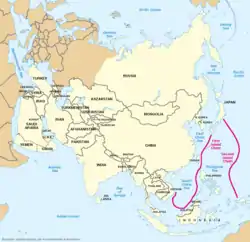First island chain
The first island chain refers to the first chain of major archipelagos out from the East Asian continental mainland coast. Principally composed of the Kuril Islands, Japanese Archipelago, Ryukyu Islands, Taiwan (Formosa), the northern Philippines, and Borneo; from the Kamchatka Peninsula to the Malay Peninsula. Some definitions of the first island chain anchor the northern end on the Russian Far East coast north of Sakhalin Island, with Sakhalin Island being the first link in the chain.[1] However, others consider the Aleutians as the farthest north-eastern first link in the chain.[2] The first island chain forms one of three island chain doctrines within the Island Chain Strategy.

.jpg.webp)
Geographic location
The first island chain is roughly situated in waters claimed and controlled by the PRC. These include the South China Sea, within the Nine-Dash Line, the East China Sea within the Okinawa Trough. The boundary between Okinawa and China lies between Japan and Taiwan.
Strategic value
US General Douglas MacArthur pointed out that before World War II, the US protected its western shores with a line of defense from Hawaii, Guam, to the Philippines. However this line of defense was attacked by Japan with the Pearl Harbor bombing of 1941, thereby drawing the US into the war. The US subsequently launched the air Raid on Taipei (Taiwan at the time part of Japan's empire) and launched the atomic bombings of Hiroshima and Nagasaki. The WW2 victory allowed the US to expand its line of defense further east to the coast of Asia, and thus the US controlled the first island chain.[3]
Between the end of WW2 and the Korean War, MacArthur praised Taiwan, located at the midpoint of the first island chain, as an 'unsinkable aircraft carrier'.[4]
In 2014 April, the United States Naval Academy assessed that the first island chain is the most effective point to counter any PLA invasion. The US can cut off the PLA Navy from entering the western Pacific, but also through the defense of other first chain countries predict the movements of the PLA. The US and first chain countries are able to coordinate because of the US military's freedom of navigation in the first chain block. US troops can effectively defend and counterattacks by the PLA. Especially if other first chain countries deploy their own underwater mines, submarine, and high-speed warships, the PLA stands little chance. According to the PLA, to dealing with these countermeasures requires greater naval technology and saving manpower costs.[5]
Taiwan
In the 'blockade chain' of the first island chain, Taiwan is the most critical. It is located at the midpoint of the first chain and occupies a strategic position.
Chinese mainland
Gao Hong, an expert on Japan, said that the first island chain is a scheme by the US-Japan alliance to encircle and trap China. The first chain is to prevent China from accessing deep waters. But the biggest threat to the PLA would be land-based missiles and increased aircraft carriers and naval fleets.
According to a 2018 report to the US Congress, China’s A2/AD military capabilities aimed at the first island chain is the most robust.[6] It also says that the country's navy's ability to perform missions beyond the first island chain is "modest but growing as it gains experience operating in distant waters and acquires larger and more advanced platforms."[6]
Japan
The Cabinet of Japan passed a defense white paper emphasizing the 'threat of the Chinese navy'. In Japan's report on the frequent PLAN activities, there were many mentions of the first and second island chains. The movements of the PLAN are often linked to breaking through the island chains.
In 2009 July, Hong Kong's Asia Weekly published an article saying that Japan pushed 500 km towards China by stationing troops on the island of Yonaguni. This was a move not only strengthening control over the Diaoyu Islands and improving first chain military containment of the mainland, but also preparing for preemptive strike in case of potential conflict with mainland China.
Japan's strategic position in the first chain began with US-Japan joint efforts to counter Soviet expansion. The current PLAN strategy imitates the defensive thinking of the Soviet navy during the Cold war. During the cold war, the Soviet navy drew the Sea of Okhotsk red line to warn periphery countries not to enter. Likewise the PLAN strategy imitates these methods to control the South, East, Yellow seas, etc. in the areas associated with the first and second island chains. As a result, the PLA is using many of the Soviet-era Cold war equipment and weapons. Japan's self defense force mainly plays the role of protecting US military bases and preserving military strength in the face of China. As for Japan's Territorial Protection Self-Defense Forces, which mainly rely on islands in southern Japan adjacent to the Yellow Sea and the East China Sea, Japan has strong military advantages in anti-submarine, air defense and sea mine technologies. Previous experience in competing with the Soviet Union has given Japan a clearer direction to cooperate with the US military in confronting the PLA's naval and air forces.[7]
Entities along the chain
According to a former director of the US Center for Strategic and Budgetary Assessments, the most important entities on the chain are (in decreasing order of importance): Japan, Philippines, Taiwan, and Vietnam.
See also
References
- Wiktionary: first island chain
- "People's Liberation Navy - Offshore Defense". globalsecurity.org. GlobalSecurity.org.
- Duffy, Bernard K. (1997). Douglas MacArthur : warrior as wordsmith. Greenwood Press. pp. 178–179. ISBN 0313291489. OCLC 636642115.
- Diplomat, Michael Mazza, The. "Why Taiwan Matters". The Diplomat. Retrieved 2019-06-10.
- "Defend the First Island Chain". U.S. Naval Institute. 2014-04-01. Retrieved 2019-06-10.
- "Annual Report to Congress: Military and security developments involving the PRC 2018" (PDF). Office of Secretary of Defense. 16 May 2018.
- "The Future of Sino-Japanese Competition at Sea". nippon.com. 2012-03-23. Retrieved 2019-06-10.
